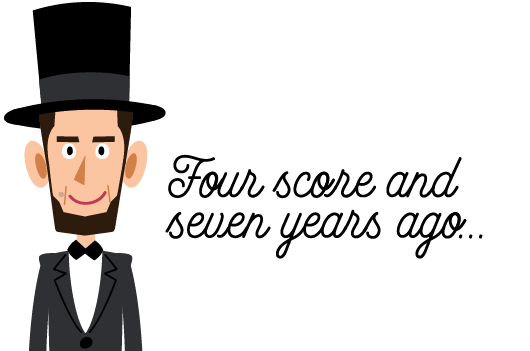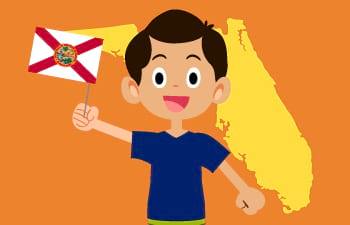On February 12 of each year, we stop to remember the life and accomplishments of our 16th president, Abraham Lincoln. Sometimes called “The Great Emancipator,” Lincoln issued the Emancipation Proclamation, which eventually led to the freeing of all slaves in the USA. Although his birthday is not a federal holiday, states such as Connecticut, Illinois, Indiana, Ohio, Missouri, and New York, still officially celebrate the event.
If you’d like to learn more this notable president, we’ve created an American Presidents unit study covering some of the important facts about Abraham Lincoln. Would you like to know how old Lincoln was when he was elected to office? Are you curious to find out how many cities in America are named after him? Then let’s get started!
Abraham Lincoln Fast Facts
| Presidential Order | 16th President |
|---|---|
| Political Party | National Union Party (Republican) |
| Born | February 12, 1809 |
| Death | April 15, 1865 |
| State of Birth | Kentucky |
| Name of Spouse | Mary Todd |
| Served as President | 1861 – 1865 |
| Age When Elected to Office | 52 |
| Vice Presidents | Had 2 Vice Presidents:
|
Character is like a tree and reputation like a shadow. The shadow is what we think of it; the tree is the real thing.
Abraham Lincoln Timeline
1809
In a log cabin in Hardin County, Kentucky, Abraham Lincoln was born on February 12.
1818
Lincoln’s mother dies of “milk sickness” when he is only 9 years old.
1828
Lincoln viewed his first ever slave auction on a trip to New Orleans.
1831
Now a young man, Lincoln began living independently of his family and becomes a live-in clerk at a village store in New Salem, IL.
1834
Beginning his political career, Lincoln was elected as a Whig party member of the IL state legislature.
1842
Wedding bells rang when Lincoln married Kentuckian Mary Todd on November 4.
1844
Lincoln became a partner in a law practice in IL.
1860
Lincoln was nominated to become the Republican candidate for United States President and is successfully elected.
1861
Civil war erupted on April 12 when Confederate artillery opens fire on Fort Sumter in Charleston Harbor.
1862
Lincoln issued a preliminary Emancipation Proclamation on September 22 freeing the slaves.
1863
Lincoln Issued a final Emancipation Proclamation on January 1 freeing all slaves in Confederate territories.
1863
On November 19, Lincoln delivered the Gettysburg Address and dedicated the battle site as a National Cemetery.
1864
Lincoln successfully re-elected for a second term as U.S. President.
1865
- April 9th — General Robert E. Lee surrendered his Confederate Army to General Ulysses S. Grant, ending the Civil War.
- April 14th — While attending a play at Ford’s Theatre, Lincoln was shot in the head by John Wilkes Booth. He died the next morning.
Fun Facts About Abraham Lincoln
Naturally, an Abraham Lincoln unit study should definitely include his main personal, political, and historical accomplishments. However, homeschoolers will also enjoy discovering some of the lesser known facts about America’s 16th president.
-
Lincoln is the only president to have obtained a patent for an invention. He designed a system of tubes that could keep boats afloat in very shallow waters.
-
Abraham Lincoln, who was 6 feet 4 inches in height, was the tallest president ever elected.
-
Although he had very little formal education, Lincoln taught himself at home by reading borrowed books and newspapers. (That’s right! Lincoln was an unschooler!)
-
The national holiday of Thanksgiving was established by Abraham Lincoln in 1863.
-
Abraham Lincoln never had a middle name.
-
Lincoln ran for the U.S. Senate two different times and lost.
-
The top hat that he was well-known for wearing was often where Lincoln kept important papers tucked away.
-
Lincoln was an accomplished wrestler, and is actually included in the Wrestling Hall of Fame.
-
Three cities in the United States are named after President Lincoln. (Lincoln, Illinois, Lincoln, Nebraska, and Lincoln, Rhode Island)
-
The Lincoln Memorial in Washington was the site of Martin Luther King Jr.’s, I Have a Dream speech in 1963.
-
In 1863 and 1864 President Lincoln granted statehood to West Virginia and Nevada, respectively.
Hands-On Activities for Abraham Lincoln Unit Study
You’ve learned so many interesting facts about Abraham Lincoln, but we all know there is no better way to make learning stick than by multisensory learning. Below, you will find ideas, organized by grade level, for incorporating hands-on learning into your Abraham Lincoln history study.
Elementary Abraham Lincoln Activities
-
Are you taller than Abe Lincoln? Using measuring tools, your student should mark Lincoln’s height on poster board attached to the wall. Then, the student should mark his or her own height. Using subtraction, compare the heights and find the difference.
-
Check out a book about Abraham Lincoln’s childhood from your local library. If possible, select a book that describes the log cabin he lived in. Then, pick up some stick pretzels and peanut butter from the grocery store and have fun building an edible version of Lincoln’s boyhood home!
Middle School Abraham Lincoln Activities
-
Ahead of time, create a coordinate grid of Abraham Lincoln’s top hat on graph paper. Supply only the coordinates to your student so that he/she can connect the dots to discover the “mystery picture.”
-
An oxymoron is a figure of speech where two seemingly opposing words are paired together. “Civil War” is an example of an oxymoron. Another example of an oxymoron is “minor catastrophe.” Have your student think of, and list 5-10 other oxymorons.
High School Abraham Lincoln Activities
-
On art paper, have your student create an outline of Abraham Lincoln’s profile with pen or marker. Then, using different colored markers, and different size words, have them create a “word cloud” of words inside the profile outline associated with the 16th president.
-
Have you heard of some of the amazing similarities between Abraham Lincoln and John F. Kennedy? For example, following their assassinations, they were both succeeded by men named “Johnson.” Also, Lincoln had a secretary named “Kennedy” and Kennedy had a secretary named “Lincoln.” Have your student do some research on the connections between the two presidents and create a PowerPoint slideshow of the ones they find the most interesting.
Quick Abraham Lincoln Spelling Words
| abolitionist | equality |
| antagonism | freedom |
| deliberation | slavery |
| democracy | sovereignty |
| endure | struggle |






